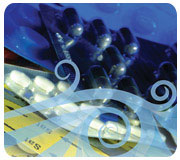
The bad news is that energy efficiency has understandably never been job one in the pharmaceutical industry. The good news is that opportunities abound for real progress as a new emphasis on sustainability grows. The author offers more than a daily dose of industry-specific insight while outlining why higher efficiency need not be a bitter pill to swallow.
Historically, pharmaceutical facilities have been designed with little regard to energy efficiency. Product quality has, rightly, trumped all other considerations. Systems have been designed for greatest assurance of consistent environmental conditions, with constant volume / reheat and high air change rates the order of the day. Steps to prevent cross-contamination in multi-product plants have been draconian, ranging from 100% fresh air/exhaust to multiple series HEPA filters in supply and exhaust.

Figure
1. Recent regulatory developments and the rise of the risk-based
approach.
In this article, we will explore principles to apply in the first step of the HVAC design process to yield greater energy efficiency.
Background
Global regulators are leading the way by challenging the life sciences industry to take a different approach to setting parameters for product processing. Gone are the days of “risk avoidance,” when designers were encouraged to eliminate every conceivable risk - regulation now focuses on “risk management and product knowledge.”Applying this systems thinking to pharmaceutical manufacturing lowers the cost of drug manufacturing while improving quality by focusing energy on product knowledge and minimizing non-value added activities. This is great for sustainability. In the past, challenging HVAC practices in biotech and pharmaceutical facilities at the most fundamental level ran headlong into the desire to eliminate risk. Corporate standards for environmental conditions, air change rates, percentage of fresh air, etc., handcuffed the HVAC engineer by making conservative rules of thumb mandatory.

Figure
2. Sterile manufacturing particle counts, in operation.
Statement of Principles for Sustainable Pharmaceutical HVAC
- Don’t apply standards blindly.
- Utilize enough air to reliably produce the desired results, don’t focus solely on air change rates.
- Turn down airflows when not in use.
- Consider all air filtration in caluclations to produce desired conditions.
- Recirculate air whenever safe and practical.
- Broaden temperature and rh limits as much as allowable by the product and process.
- Use micro-environments wherever practical.
The following recommendations all come with the same caveat; as we’ve outlined above, it’s incumbent on the user and designer to verify the actual needs and risks of their process and prove the effectiveness of the implemented system.
Air Change Rates
Historically, rules of thumb for pharmaceutical cleanrooms have specified air change rates starting at 20 ach for ISO 8 and 9 (Grade C and D) rooms and increasing to 40, 60, and sometimes even 100 for ISO 7 (Grade B) spaces. Real-world environmental monitoring, however, shows that rooms operating at these air-change rates often achieve dynamic contamination levels orders of magnitude cleaner than specified.In Figure 2, the cleanrooms achieve particle counts 1.5 to 2 orders of magnitude better than specified. Why is this? One reason is that while air change rates relate inversely to the recovery of a room and the time it takes to reach steady state, it’s the particle generation rates and the diluting (or displacing) airflow that really influence the particle count achieved. If we neglect the contribution from supply air (which should be small) the steady state concentration can be approximated as: Cf= Ci+( (PGRpx N) +PGRm)/Q )
Where:
Cf= Room particle count (particles/volume)
Ci= Initial particle count (particles/volume)
PGRp= Particle generation rate from people (particles/person minute)
PGRm= Particle generation rate from process (particles/minute)
N = Number of people in the clean room
Q = supply air volume/minute
Another reason is that personnel are a key source of particulates, advances in gowning, automation, and isolation have decreased how many people are in the cleanroom and how much they shed, which has had a huge impact on modern cleanroom performance.
If we design cleanrooms by evaluating the particle generation rates and providing enough diluting (or displacing) airflow, rather than using rules of thumb for air changes, we can create more efficient cleanrooms and may save 10% to 30% of cleanroom energy consumption.
Airflow and Environmental Setbacks
Office and laboratories often benefit from an off-hours or unoccupied setback of environmental conditions. These schemes usually include a reduction in airflow (sometimes a shutdown of AHUs altogether) and a relaxation of temperature and rh setpoints for energy savings. Can these energy-saving schemes be applied to pharmaceutical manufacturing?When tested “at rest” (without people), cleanrooms typically perform one to two orders of magnitude better than “in operation.” In fact, Annex 1, the European guidance for “Manufacture of Sterile Medicinal Products” specifies this level of performance at rest.

Figure
3. Typical cleanroom recovery performance.
We can leverage the exceeding performance when at rest to establish a protocol for reduced airflow and relaxed environmental controls during idle periods. What’s more, recovery testing suggests a method of test (MOT is found in ISO 14644-3) for proving the restoration of manufacturing conditions.
We suggest the following parameters be considered in establishing an idle “setback” for environmental conditions in pharmaceutical manufacturing facilities:
- Do not store product or product contact materials open within the space during setback periods;
- Maintain sufficient ventilation to offset heat gains;
- Maintain design pressure differentials to adjacent spaces for contamination control;
- Consider mold and microbial growth conditions when arriving at relaxed rh setpoints (exceeding 80% rh is not recommended );
- Consider thermal inertia in equipment and construction when arriving at relaxed temperature setpoints;
- Verify the time required to restore environmental conditions after an idle period via EM testing.
Filtration
The prevention of cross-contamination of facilities engaged in concurrent manufacturing of multiple products has driven the prevalence of double HEPA filtration in this application and in some single product plants (this includes multi-product campaign facilities). Double HEPA filters are a very positive method of controlling the HVAC system as a path of cross-contamination. But is there a lower energy alternative?
Figure
4. A composite efficiency profile of MERV-rated filters related by
particle size, based on initial conditions. (Graph courtesy of NAFA,
Summer 2002 issue of Air
Media.
Author(s): W. J. Kowalski, P.E., Ph.D. and W. P. Bahnfleth, P.E.,
Ph.D., The Pennsylvania State University.)

Table
1. Particulate generation by gowning and activity stated in
particles/min.

Table
2. These comparisons of filter rating systems are only approximate as
the test methods are different.
While the ever-increasing potency of compounds imposes an escalating burden of care in the prevention of cross-contamination, accounting for the protection afforded by all filters in a system allows for lower pressure drops than dual HEPAs and further energy savings.
Recirculation
Conditioned fresh air can consume two to five times the energy of recirculated air. The effectiveness of filtration in removing the mass of contaminants reveals another opportunity for energy savings. By employing appropriate filtration, we can trade fan horsepower for the much larger chiller, cooling tower, pump, and boiler horsepower. The application of systems like those outlined above or double HEPA filtration produces an 8-log reduction in mass. With this high reduction in mass, a failure of any single element, the system will retain a 2- to 4-log protection, which may be sufficient for lower potency products.
Figure
5. Central station outside air AHU with local recirculation.
Using this scheme, we can achieve the product separation that potent multi-product plants require, with 50% to 80% less energy usage than systems using 100% outside air (OA).
Broad Temperature and RH limits
In the setting of temperature and rh setpoints, we have also seen the prevalence of application of rules of thumb which may not be linked with the product or process requirements. The conservatism is well appreciated, and failure to recognize a product/process rh requirement could result in significant product quality and processing problems. To avoid these repercussions, some companies default to operating “Oral Solid Dose” manufacturing suites at 30% to 40% rh and even as low as 15% to 20% rh.Where processes are closed or product/process restrictions are beyond the ambient temperature range, controlling the growth of microorganisms may become the primary acceptance criterion, with human comfort (and associated shedding) the secondary requirement. The acceptable range of temperatures and relative humidities varies broadly by region, gowning, and activity (see Chapter 9 in the 2005 ASHRAE Handbook – Fundamentals). Acceptable ranges for pharmaceutical operators are often as broad as 64°F to 78° and 30% to 60% rh. Some have successfully operated with setpoints as high as 70% rh, but operation above 80% rh is not recommended.
Again, the energy savings potential can be great. A facility running at 30% rh or lower likely employs an desiccant dehumidifier, which would not be required if humidity were closer to the 50% range. The savings from relaxing humidity requirements of 30% to 40% rh up to 50% to 60% may reduce energy usage by 10% to 25%.
Microenvironments
One of the most significant sustainability developments in pharmaceutical processing in recent years has been the rise of the closed processing in contained microenvironments. Technologies such as sterile barrier and containment isolation, blow-fill-seal, contained process equipment, and “dustless” transfers via split butterfly valves, continuous liners, inflatable seals, and numerous others have redefined pharmaceutical HVAC.While intended for operator protection, improved sterility assurance, or yield enhancement these technologies have effectively moved the critical environment closer to the process. They have made the occupied environment a secondary zone, reducing the need for contamination control via dilution from HVAC.
As one prominent architect put it when referring to a new sterile processing suite containing a complete barrier isolation line: “We’re just building the garage to park the process team’s Ferrari in …” As these technologies continue to reduce the need for highly controlled room environments, the opportunities for greater energy savings will continue to expand.

